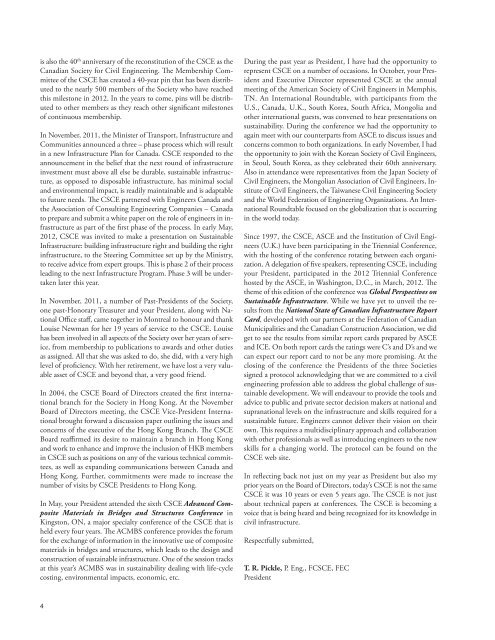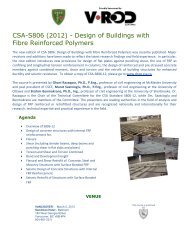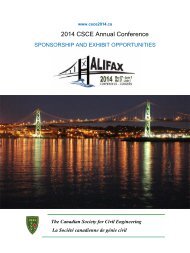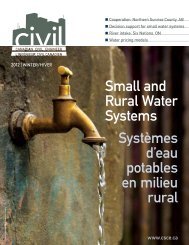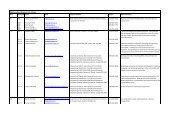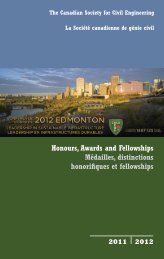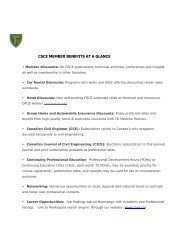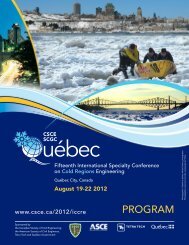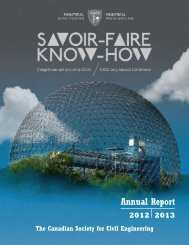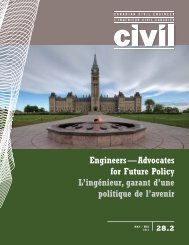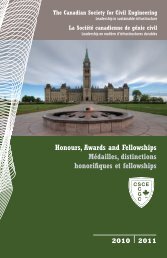Annual Report 2011 - CSCE ⢠Canadian Society for Civil Engineering
Annual Report 2011 - CSCE ⢠Canadian Society for Civil Engineering
Annual Report 2011 - CSCE ⢠Canadian Society for Civil Engineering
You also want an ePaper? Increase the reach of your titles
YUMPU automatically turns print PDFs into web optimized ePapers that Google loves.
is also the 40 th anniversary of the reconstitution of the <strong>CSCE</strong> as the<strong>Canadian</strong> <strong>Society</strong> <strong>for</strong> <strong>Civil</strong> <strong>Engineering</strong>. The Membership Committeeof the <strong>CSCE</strong> has created a 40-year pin that has been distributedto the nearly 500 members of the <strong>Society</strong> who have reachedthis milestone in 2012. In the years to come, pins will be distributedto other members as they reach other significant milestonesof continuous membership.In November, <strong>2011</strong>, the Minister of Transport, Infrastructure andCommunities announced a three – phase process which will resultin a new Infrastructure Plan <strong>for</strong> Canada. <strong>CSCE</strong> responded to theannouncement in the belief that the next round of infrastructureinvestment must above all else be durable, sustainable infrastructure,as opposed to disposable infrastructure, has minimal socialand environmental impact, is readily maintainable and is adaptableto future needs. The <strong>CSCE</strong> partnered with Engineers Canada andthe Association of Consulting <strong>Engineering</strong> Companies – Canadato prepare and submit a white paper on the role of engineers in infrastructureas part of the first phase of the process. In early May,2012, <strong>CSCE</strong> was invited to make a presentation on SustainableInfrastructure: building infrastructure right and building the rightinfrastructure, to the Steering Committee set up by the Ministry,to receive advice from expert groups. This is phase 2 of their processleading to the next Infrastructure Program. Phase 3 will be undertakenlater this year.In November, <strong>2011</strong>, a number of Past-Presidents of the <strong>Society</strong>,one past-Honorary Treasurer and your President, along with NationalOffice staff, came together in Montreal to honour and thankLouise Newman <strong>for</strong> her 19 years of service to the <strong>CSCE</strong>. Louisehas been involved in all aspects of the <strong>Society</strong> over her years of service,from membership to publications to awards and other dutiesas assigned. All that she was asked to do, she did, with a very highlevel of proficiency. With her retirement, we have lost a very valuableasset of <strong>CSCE</strong> and beyond that, a very good friend.In 2004, the <strong>CSCE</strong> Board of Directors created the first internationalbranch <strong>for</strong> the <strong>Society</strong> in Hong Kong. At the NovemberBoard of Directors meeting, the <strong>CSCE</strong> Vice-President Internationalbrought <strong>for</strong>ward a discussion paper outlining the issues andconcerns of the executive of the Hong Kong Branch. The <strong>CSCE</strong>Board reaffirmed its desire to maintain a branch in Hong Kongand work to enhance and improve the inclusion of HKB membersin <strong>CSCE</strong> such as positions on any of the various technical committees,as well as expanding communications between Canada andHong Kong. Further, commitments were made to increase thenumber of visits by <strong>CSCE</strong> Presidents to Hong Kong.In May, your President attended the sixth <strong>CSCE</strong> Advanced CompositeMaterials in Bridges and Structures Conference inKingston, ON, a major specialty conference of the <strong>CSCE</strong> that isheld every four years. The ACMBS conference provides the <strong>for</strong>um<strong>for</strong> the exchange of in<strong>for</strong>mation in the innovative use of compositematerials in bridges and structures, which leads to the design andconstruction of sustainable infrastructure. One of the session tracksat this year’s ACMBS was in sustainability dealing with life-cyclecosting, environmental impacts, economic, etc.During the past year as President, I have had the opportunity torepresent <strong>CSCE</strong> on a number of occasions. In October, your Presidentand Executive Director represented <strong>CSCE</strong> at the annualmeeting of the American <strong>Society</strong> of <strong>Civil</strong> Engineers in Memphis,TN. An International Roundtable, with participants from theU.S., Canada, U.K., South Korea, South Africa, Mongolia andother international guests, was convened to hear presentations onsustainability. During the conference we had the opportunity toagain meet with our counterparts from ASCE to discuss issues andconcerns common to both organizations. In early November, I hadthe opportunity to join with the Korean <strong>Society</strong> of <strong>Civil</strong> Engineers,in Seoul, South Korea, as they celebrated their 60th anniversary.Also in attendance were representatives from the Japan <strong>Society</strong> of<strong>Civil</strong> Engineers, the Mongolian Association of <strong>Civil</strong> Engineers, Instituteof <strong>Civil</strong> Engineers, the Taiwanese <strong>Civil</strong> <strong>Engineering</strong> <strong>Society</strong>and the World Federation of <strong>Engineering</strong> Organizations. An InternationalRoundtable focused on the globalization that is occurringin the world today.Since 1997, the <strong>CSCE</strong>, ASCE and the Institution of <strong>Civil</strong> Engineers(U.K.) have been participating in the Triennial Conference,with the hosting of the conference rotating between each organization.A delegation of five speakers, representing <strong>CSCE</strong>, includingyour President, participated in the 2012 Triennial Conferencehosted by the ASCE, in Washington, D.C., in March, 2012. Thetheme of this edition of the conference was Global Perspectives onSustainable Infrastructure. While we have yet to unveil the resultsfrom the National State of <strong>Canadian</strong> Infrastructure <strong>Report</strong>Card, developed with our partners at the Federation of <strong>Canadian</strong>Municipalities and the <strong>Canadian</strong> Construction Association, we didget to see the results from similar report cards prepared by ASCEand ICE. On both report cards the ratings were C’s and D’s and wecan expect our report card to not be any more promising. At theclosing of the conference the Presidents of the three Societiessigned a protocol acknowledging that we are committed to a civilengineering profession able to address the global challenge of sustainabledevelopment. We will endeavour to provide the tools andadvice to public and private sector decision makers at national andsupranational levels on the infrastructure and skills required <strong>for</strong> asustainable future. Engineers cannot deliver their vision on theirown. This requires a multidisciplinary approach and collaborationwith other professionals as well as introducing engineers to the newskills <strong>for</strong> a changing world. The protocol can be found on the<strong>CSCE</strong> web site.In reflecting back not just on my year as President but also myprior years on the Board of Directors, today’s <strong>CSCE</strong> is not the same<strong>CSCE</strong> it was 10 years or even 5 years ago. The <strong>CSCE</strong> is not justabout technical papers at conferences. The <strong>CSCE</strong> is becoming avoice that is being heard and being recognized <strong>for</strong> its knowledge incivil infrastructure.Respectfully submitted,T. R. Pickle, P. Eng., F<strong>CSCE</strong>, FECPresident4


